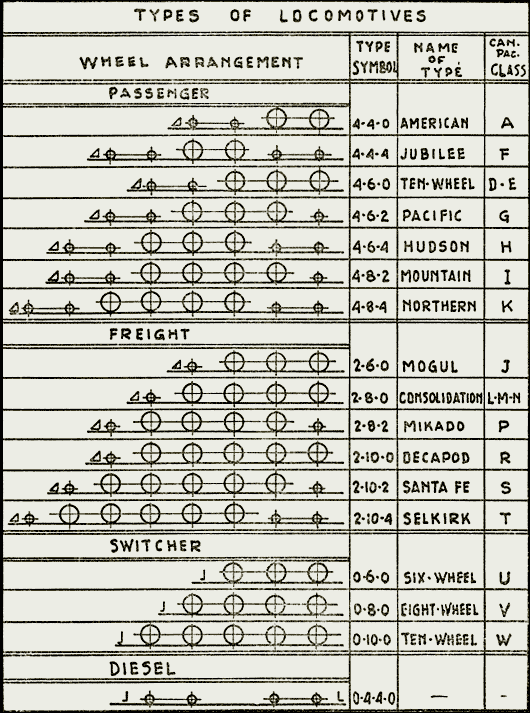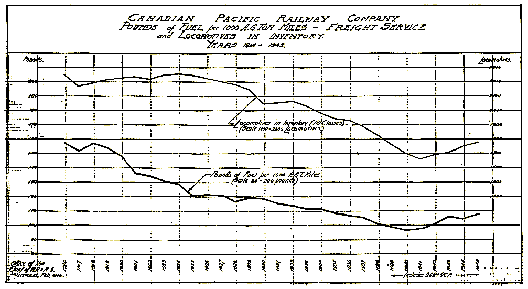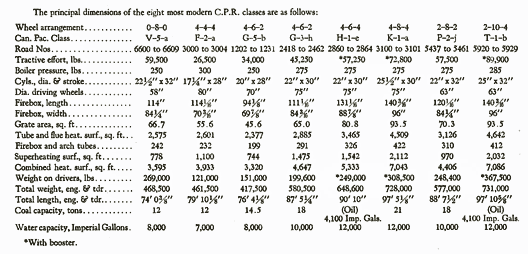
TYPES OF LOCOMOTIVES
By H.B. Bowen
Chief of Motive Power and Rolling Stock

A Canadian Pacific Railway 4-4-4 Jubilee class F1a with the streamlining removed showing the underlying support
structure - Date/Photographer unknown.
 Introduction Many years ago Canadian Pacific published a series of ten books named the "Foundation Library". One particular book
added to this collection, published in 1946, is named "Canadian Pacific Facts and Figures". It contains many short stories and articles
dealing with the company during that period. This month's article from that book, "Types of Locomotives", written by H.B. Bowen,
Chief of Motive Power and Rolling Stock, is reprinted here for your enlightenment with the addition of some appropriate images.
 The 1946 Article The steam locomotive of today represents over a century of improvement. Step by step, it has been developed, from the elementary
units of Trevethick and Stevenson, to become the powerful, efficient, locomotives upon which the land transport of the world depends.
During the long period of railway operation, desire for increased power and greater economy has brought about the development of
many different types of locomotives, each especially suited to meet particular conditions. This evolution from the basic types has been most
marked in the United States and Canada, as in these countries ample loading gauge dimensions of approximately 16 feet in height, by 11 feet in
width, have permitted designers to advance in the construction of large locomotives suitable for movement of the heavy trains characteristic of
this continent.
 Symbols Classify Engines Symbols, names, and letter classifications, based upon the wheel arrangement of the locomotive, exclusive of tender wheels, are
used for identification of locomotive types. The various basic types have been produced by many combinations of truck and driving wheels, each
wheel arrangement becoming an individual type. This method of identification has become universal, and is applied to locomotives of the Company as
on accompanying diagram.

From this diagram it will be noted that each group of engine truck wheels, driving wheels, and trailing truck wheels, is
separated, with a symbol representing each group.
If no trucks are used, as in switching locomotives, their absence is shown by the symbol 0. For example, a six-wheel switcher is
designated 0-6-0, the centre digit representing the six driving wheels.
In addition to symbols, type names are used, being usually assigned to the first locomotives built with a new wheel arrangement,
and are later generally adopted to signify this type.
Also, for convenience, railway companies identify their own types of locomotives by a series of letter classifications.
For example, a locomotive having a four-wheeled engine truck, four driving wheels, and a four-wheeled trailing truck, would be
symbolized by the figures 4-4-4. The Company has a number of locomotives with this wheel arrangement, to which was given the name
"Jubilee" type in commemoration of the 50th anniversary of the Company's operation. The letter classification of this group is
"F", which in addition carries a number, and a sub letter, indicating a sequence of construction orders, or of minor changes in design,
the final classification becoming F1a, F2a, etc.
For many years a two-wheeled engine truck was generally used in freight service, while locomotives having a four-wheeled engine
truck were standard for passenger service. Today, the advent of long engine runs and higher freight train speeds, has led to the extension of
application of four-wheeled engine trucks to locomotives used in freight service, or interchangeably in either service.
Trailing trucks having two wheels, have been almost entirely superseded by trucks having four wheels, as the weight of
locomotives has increased. A few six-wheeled trailing trucks have been applied.
It will thus be apparent that this system of identification not only serves to cover various wheel arrangements, but also to
indicate the approximate age of the type, the service for which it was designed, and the size and power of the unit.
While an increase in the number of wheels has brought about construction of successively larger and heavier units, there has also
been a need for small modern locomotives to meet specific traffic and operating needs, as exemplified in the introduction by this company of
modern 4-6-2 Pacific type, Class G5b locomotives. These engines are designed to replace older types of motive power, and have been given a weight
distribution on the wheels which permits them to be used, not only on main lines, but on most of the branch lines of the Company. Ample boiler
capacity and strict attention to details have been primary considerations. The principal dimensions of several types of locomotives used by the
Company are given at the end of this article.
 Tremendous Advances in Locomotives Development of the steam locomotive during the past 25 years has resulted in increased hauling capacity and greater economy. This
in turn has produced a reduction in the number of locomotives required in the inventory. During the same period, there has been a considerable
increase in train speed, in total tonnage moved, in availability of locomotives,and in locomotive mileage. This has been accomplished with a great
reduction in fuel consumption per ton of freight moved one mile, while the cost of maintenance per locomotive mile has remained almost constant,
as shown on the attached diagram.

 Record Locomotive Performances Probably the Company's best known locomotives are 4-6-4 "Royal Hudson" locomotives, (Classes H1c-d-e), which are so
named by permission of the British Government to commemorate the visit of the King and Queen to Canada in 1939. They are numbered from Engine
2820 upwards, and bear a crown on the running board scarf plate at each side.
The Royal Train was hauled from Quebec City to Vancouver by Locomotive No. 2850. This engine was most attractively finished,
having a boiler jacket of highly polished stainless steel, a general painting scheme in royal blue, and with decorations in silver and gold. On
the front end of the streamlined smokebox was mounted the Royal Arms, the side of the running boards bore the Imperial Crown, the Company crest
appeared beneath the cab windows, and on each side of the tender was displayed the Royal Arms on a large plaque.
The performance of this locomotive was remarkable, since during a journey of approximately 3,100 miles, no mechanical trouble
occurred, and the engine was assisted only over the steepest grades of the Canadian Rockies.
Other engines of this class have given remarkable performance records. Locomotives 2838, 2839, 2840, and 2841 on the Toronto-Fort
William run averaged in excess of 400 miles per day in ten months of continuous service. Locomotive 2858 has averaged 534 miles per day during
nine months of continuous service, and Locomotive 2859 averaged 596 miles per day for eight continuous months of service.
Outstanding records have also been made by other classes. For example, 4-8-4 Northern class K1a engines 3100 and 3101, on the
Montreal-Toronto night run, averaged 350 miles daily for 12 continuous months of service.
 Diesel Locomotives In 1943 the Company introduced diesel-electric locomotives for switching service in units of the
0-4-4-0 type, 1,000 H.P., equipped with one six-cylinder supercharged diesel engine, furnishing current to four driving motors. They have an
overall length of 45 feet 5 3/4 inches, total weight of 230,000 pounds, and a starting tractive effort of 69,000 pounds. Twenty-eight of these
engines were in service in 1945.
Further development of diesel-powered locomotives is in progress, intended to advance the availability and economy of this
modern type of motive power.

 Associated Web Sites Canadian Pacific Railway
Canadian Pacific Historical Association
Additional CPR Web Sites

|

